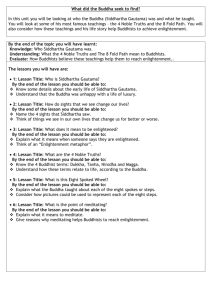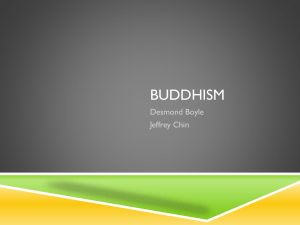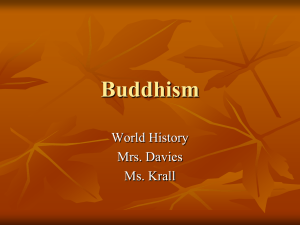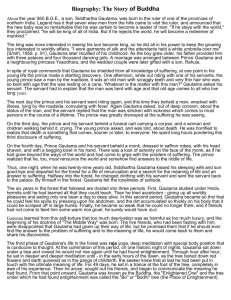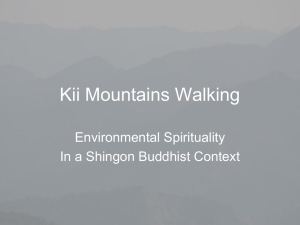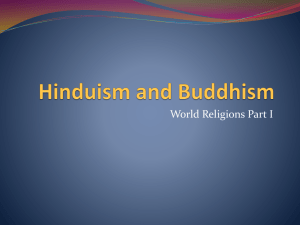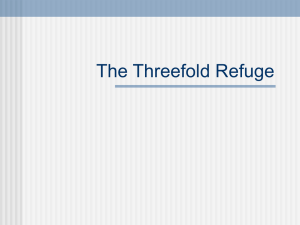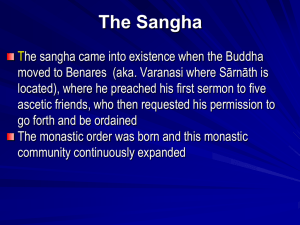The life of the Buddha
advertisement
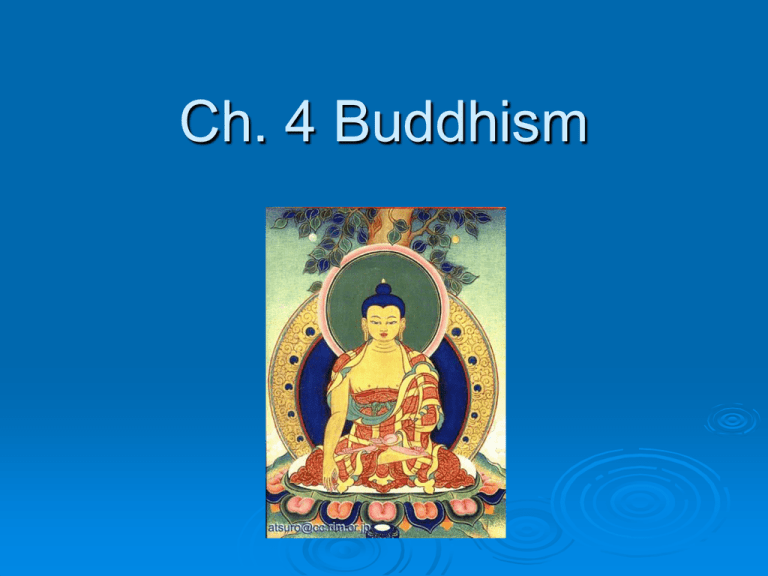
Ch. 4 Buddhism Origins Place India- originated Spread throughout Asia Time th Century BCE (when 5 the Upanishads were composed) Founder Siddhartha Guatama 2 Siddhartha Gautama Siddhartha Gautama was born c. 563 BCE in Northern India He was born in Nepal – in the lower Himalaya Mountains. Siddhartha was born the son of a prince warrior (kshatriya) caste Father a regional ruler, making Gautama a prince Legend says that his mother, Maya, dreamt that a white elephant entered her side- this was the moment of conception of the future Buddha He was born miraculously from his mother side. His mother died a week after childbirth Siddhartha was raised by his aunt. 3 1. 2. A sage inspected the child and saw special marks on Siddhartha’s body and foretold that his life could go in one of two directions: Becoming a king, “a world ruler,” following his father’s footsteps and inheriting his positions He would become a great spiritual leader, “a world teacher” if he were exposed to the sight of suffering. Siddhartha’s father took measure to keep him from exposure to suffering because he wanted him to take his place in the future. Siddhartha grew up in a luxurious large walled palace He married at a young age to a woman his father chose and had a son with her Siddhartha was educated and trained as a warrior The Four Passing Sights 1. 2. 3. 4. One day Siddhartha disobeyed his father’s command not to leave the royal grounds. He encountered suffering in an episode known as the Four Passing Sights He came across an old man, crooked and toothless A sick man, wasted by disease A corpse being taken for cremation A sannyasin who had no possessions but seemed to be at peace Siddhartha’s reality Having seen the reality of suffering, Gautama knew that he would never again find contentment in the luxuries of the palace. He did not feel safe anymore now that he knew the truths of old age, disease, and death. Siddhartha decided to overcome his despair The Great Going Forth At age 29, Siddhartha decided to renounce his life as a prince, left his family secretly in the dark of night. Gave his horse to his servant, cut his long black hair and put on simple clothes, this event is called the great going forth. He joined a group of five mendicants who practiced asceticism to win salvation. Gautama excelled in the practice of fasting, spending the next 7 years on the brink of starvation The Middle Way Starvation did not lead to salvation Gautama accepted a simple meal of rice and milk and quickly regained enough strength to proceed on his quest. His five companions left him, disgusted that he had abandoned asceticism. Gautama thus discovered the important Buddhist doctrine of the Middle Way: Neither starvation nor overindulgence • A healthy spiritual life depends on healthy physical life Being content in life is good • Spiritual happiness = happiness in body, mind, spirit Struggle under the Bodhi Tree After accepting the middle way, Siddhartha sat in the lotus position beneath a fig tree (now called the Bodhi Tree) and decided not to leave the place until he had the understanding he needed. Various traditions give different details: one says he sat for a week, another says he remained there for forty-nine days Every version talks of his struggle with hunger, thirst, doubt, and weakness The story of Mara is a popular story Mara Mara, the god of death sent his 3 daughters to tempt Siddhartha • Discontent, Delight, Desire But Gautama never gave up and never gave in After overcoming Mara and his daughters, Gautama reached Enlightenment by first entering 3 stages of awareness: Sitting under the bodhi tree, Siddhartha reached a state of profound understanding called his Awakening, or Enlightenment aka the three watches First Watch (evening) • Saw his previous lifetimes A continuous journey of suffering Second Watch (middle night) • Acquired Divine (3rd) Eye Saw deaths and rebirths of all living beings Third Watch (late night) • Perceived Four Noble Truths: – a perfect summation of human existence…and the way to end suffering. Became Enlightened He received a new name: the Buddha Buddha comes from a Sanskrit word meaning to wake up The Buddha is the Awakened one 11 Sangha After the enlightenment, the Buddha searched his five former companions and they reconciled with him and became his first followers The Buddha attracted many people The Buddha thus formed an order of monks and nuns called sangha The sangha was the first Buddhist monastic community The sangha was divided into monks, nuns, and laypeople His son became Buddhist Nirvana At the age of 80, the Buddha became extremely ill after eating a spoiled food offered by a well meaning blacksmith named Chunda The Buddha sensed that he was going to die and called his disciples. Told them that everything must die including him. He then offered a final advise: “You must be your own lamps, be your own refuges. Take refuge in nothing outside yourselves.” The Buddha then turned on his right side and died passing forever into Nirvana The Buddha today Not god but human Avatar of Vishnu Many Buddhists do not pray to him Buddhists follow his example 1. 2. 3. The Buddha’s teachings play a key role in defining the religious life of Buddhism rather than the Buddha himself. It is impossible to know exactly what the Buddha taught. He did not write down his teachings, nor did his early disciples. The only written versions were recorded several hundred years after his death. The core of what is generally regarded as basic Buddhism are the Three Jewels The Buddha The Dharma The Sangha Buddhist teachings • Practice meditation (experiential dimension) • He is an ideal human being whom other human beings should imitate • He is not usually thought of as being dead but as existing in a timeless dimension beyond the world THE BUDDHA 16 The Dharma Buddha’s teachings(doctrinal dimension)about how to view the world and how to live properly The Buddhist dharma is not the same as the Hindus dharmaethical duty 3 characteristics of Buddhist Dharma (teachings) 1. Buddhism Inner wisdom, vs. faith in God: a. Buddhist truths do not come from Divine 2. Doctrine based on revelation outside the person. observation of “what l (e.g. 10 is”. commandments, burning bush, Transfiguration) 3. A psychologicallyWorld Religions b. Buddhist truths centered religion discovered by looking Chapter 4 inside. 18 Buddha’s teachings The teachings are practical He refused to talk about god and faith His refusal to talk about something else besides how to end suffering is called his noble silence He speculated about unanswerable questions like a man who had been wounded by an arrow but refused to pull it out until he knew everything about the arrow and the person who shot it. The wounded man would die before he could get all the information he wanted. The Sangha The community of monks and nuns Monastic community Show commitment to being Buddhist (social dimension) 20

